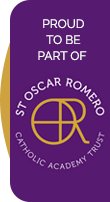Holy Innocents' Parish, Orpington
We are very fortunate at Holy Innocents' Catholic Primary School to have such close links with the parish of Holy Innocents' which is just over the road from the school.
Pupils and staff attend Mass at the Church at the start and end of term and on Holy Days of Obligation. Parents and Parishioners are always welcome to join us in these celebrations.
To find out more visit their website.






